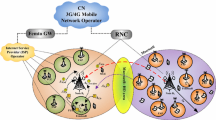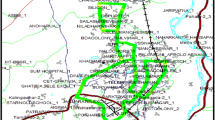Abstract
In cellular networks, a higher priority can, out of Quality of Service reasons, be given to ongoing connections than new call attempts. This can be achieved by having capacity in each cell (guard channels) exclusively reserved for arriving handover calls. In this paper, an advanced guard channel scheme, called Predictive and Adaptive Resource Reservation (PARR), will be introduced. The PARR scheme determines the amount of guard channels to allocate in a cell through subscriber movement predictions. The novelty of PARR is that both positioning and history-based measurements are used as input for the predictions. To improve the prediction accuracy, different data sets are applied for calls with different mobility and latest visited cells. Simulations will be used to show that significant performance improvements are obtainable with PARR.
Similar content being viewed by others
REFERENCES
A.-L. Beylot, S. Boumerdassi, and G. Pujolle, A new priori-tized hando. strategy using channel reservation in wireless PCN, Proceedings of IEEE GLOBECOM 1998, Vol. 3, pp. 1390–1395, 1998.
H. Chen, S. Kumar, and C. C. J. Kuo, Dynamic call admis-sion control and resource reservation with interference guard margin (IGM)for CDMA systems, Proceedings of IEEE Wireless Communications and Networking Conference 2003, Vol. 3, pp. 1568–1572, 2003.
M.-H. Chiu, and M. A. Bassiouni, Predictive schemes for hando. prioritization in cellular networks based on mobile positioning, IEEE Journal on Selected Areas in Communica-tions, Vol. 18, No. 3, pp. 510–522, 2000.
C. H. Choi, M. I. Kim, T. J. Kim, and S. J. Kim, Adaptive bandwidth reservation mechanism using mobility probability in mobile multimedia computing environment, Proceedings of IEEE Local Computer Networks 2000, pp. 76–85, 2000.
S. Choi and K. G. Shin, Predictive and adaptive bandwidth reservation for hand-o. s in QoS-sensitive cellular networks, Proceedings of ACM SIGCOMM 1998, pp. 155–166, 1998.
S. Choi and K. G. Shin, Exploiting path/location information for connection admission control in cellular networks, Pro-ceedings of Wireless Communications and Networking Confer-ence 2000, Vol. 3, pp. 935–940, 2000.
F. A. Cruz-Perez, D. Lara-Rodriguez, and M. Lara, Frac-tional channel reservation in mobile communication systems, IEEE Electronic Letters, Vol. 35, No. 23, pp. 2000–2002, 1999.
D. Hong and S. S. Rappaport, Tra. c model and perfor-mance analysis for cellular mobile radio telephone systems with prioritized and nonprioritized hando. procedures, IEEE Transactions on Vehicular Technology, Vol. 35, No. 3, pp. 77–92, 1986.
Y. Lin, A. R. Noerpel, and D. J. Harasty, The sub-rating chan-nel assignment strategy for PCS hand-o. s, IEEE Transactions on Vehicular Technology, Vol. 45, No. 1, pp. 122–130, 1996.
G. Liu and G. Maguire, Jr., A class of mobile motion predic-tion algorithms for wireless mobile computing and communi-cations, ACM Mobile Networks and Applications, Vol. 1, No. 2, pp. 113–121, 1996.
S. Lu and V. Bharghavan, Adaptive resource management algorithms for indoor mobile computing environments, ACM Computer Communication Review, Vol. 26, No. 4, pp. 231–242, 1996.
K. Shum and C. W. Sung, Fuzzy layer selection method in hierarchical cellular systems, IEEE Transactions on Vehicular Technology, Vol. 48, No. 6, pp. 1840–1849, 1999.
W.-S. Soh and H. S. Kim, Dynamic bandwidth reservation in hierarchical wireless ATM networks using GPS-based pre-diction, Proceedings of IEEE Vehicular Technology Confer-ence 1999 Fall, Vol. 1, pp. 528–532, 1999.
W.-S. Soh and H. S. Kim, QoS provisioning in cellular net-works based on mobility prediction techniques, IEEE Com-munications Magazine, Vol. 41, No. 1, pp. 86–92, 2003.
R. Zander and J. M. Karlsson, A measurement-based dynamic guard channel scheme for handover prioritization in cellular networks, Proceedings of 2nd International IFIP-TC6 Networking Conference, pp. 1245–1251, 2002.
R. Zander and J. M. Karlsson, Combining positioning and history-based measurements in dynamic guard channel schemes, Proceedings of IASTED International Conference on Communications and Computer Networks, pp. 36–41, 2002.
R. Zander and J. M. Karlsson, A zone-based bandwidth res-ervation scheme for UMTS, Proceedings of IEEE Vehicular Technology Conference 2004 Spring, 2004.
Y. Zhao, Standardization of mobile phone positioning for 3G systems, IEEE Communications Magazine, Vol. 40, No. 7, pp. 108–116, 2002.
S. Zhichun, W. Ying, Z. Ping, and L. Baoling, Layer selec-tion method using power control in hierarchical cellular sys-tems, Proceedings of IEEE Vehicular Technology Conference 2001 Spring, Vol. 4, pp. 2407–2411, 2001.
W. Zhuang, B. Bensaou, and K. Chua, Adaptive quality of service hando. priority scheme for mobile multimedia net-works, IEEE Transactions on Vehicular Technology, Vol. 49, No. 2, pp. 494–505, 2000.
Author information
Authors and Affiliations
Rights and permissions
About this article
Cite this article
Zander, R., Karlsson, J.M. Predictive and Adaptive Resource Reservation (PARR) for Cellular Networks. International Journal of Wireless Information Networks 11, 161–171 (2004). https://doi.org/10.1007/s10776-004-7874-3
Issue Date:
DOI: https://doi.org/10.1007/s10776-004-7874-3




